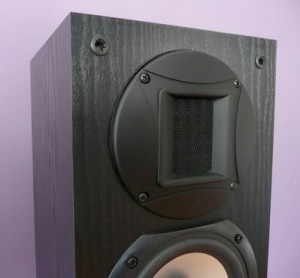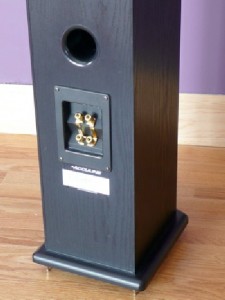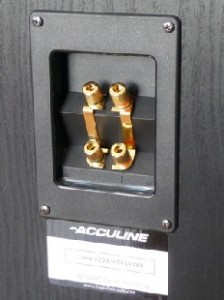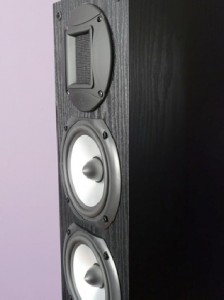The Acculine brand of speakers is a value-oriented series sold through The Audio Insider website alongside some much pricier offerings from Gamut, Swans and Dana. Though their A1 monitor did not take the top honors in the blind monitor shootout detailed in the October ‘07 edition of Affordable$$Audio, it did receive much praise for its remarkable sound quality as one of the lowest-priced entries in that competition. I was originally contacted to review the A1 monitor, but instead decided to give the floor-standing A3 a try, since this would free me from the complications of locating appropriate stands. Besides, the $250 bump in price seems like a fair trade-off, since it eliminates the cost of stands and gives you an extra mid-woofer in each cabinet for presumably deeper output.
Specifications
- 3″ wideband planar-magnetic flat-panel high frequency unit
- Dual high-excursion aluminum 135mm mid-woofers
- Bass reflex acoustic alignment
- Magnetically shielded
- Frequency Response: 45Hz-22kHz
- Sensitivity: 89dB
- Nominal Impedance: 4 Ohms
- Power Handling: 10-150W
- Finish: Simulated black ash PVC Dimensions: 39.8” x 9.1” x 9.7” Net Weight: 35lbs each
- Price per pair: $499
Acculine A3 review
The Acculine A3 is a relatively sleek, narrow tower dressed all in black. At this price point I was not expecting the fit-and-finish to be outstanding, but I was pleasantly surprised by the quality. They are reasonably weighty speakers and feel quite solid and well-damped for an economy brand. They also come with spikes that thread into the attached bottom platform. The spikes terminate with small balls on their tips which will help prevent damage to wood floors, so you’ll probably want to replace these with something sharp if you need to pierce carpet.
Another surprising feature for a speaker at this price point is the use of a 3” Radia-technology planar-magnetic flat-panel tweeter rather than a traditional dome tweeter. As a Magnepan devotee, I’ve always been partial planar drivers and very curious regarding the Radia units in particular, which have been cropping up in some highly regarded and much more expensive speakers. Below the planar tweeter on each speaker resides a pair of aluminum cone midrange/woofer drivers in a rear-ported bass reflex design. The speakers also have dual sets of binding posts to facilitate biwiring or biamping, which I made use of with my internally biwired DH Labs Q-10 speaker cables.
Warming Up
Initially, I put the A3s through some extended calisthenics in our exercise room, driving them with a vintage Pioneer SX-780 receiver. Right out of the gate it was apparent that these speakers can generate a prodigious amount of bass. Not necessarily deep, bone-rattling bass (you’ll still want a subwoofer for that), but the mid and upper bass frequencies are quite powerful, giving the music a lot of body. My wife usually just rolls her eyes at the equipment moving in and out of our rooms, but in this case she commented (unsolicitedly, I might add) that she really liked the sound of the Acculines as “they seem to fill the room.”
I agreed with my wife, but you also run the risk of getting too much of a good thing if you back them up close to a wall, which is perhaps due in part to their rear-ported design. Granted, the old Pioneer always strikes me as having a slightly over-emphasized and sometimes unruly bass response, but with the Acculines, I found I could easily exacerbate this by reducing their distance from the front wall, and moving them out only very slightly was only a temporary solution in this room. The bass on tracks like Laurie Anderson’s “Slip Away,” “One Beautiful Evening” and “My Compensation” (in particular) from her Life On A String album became overwhelming and almost ponderous, swamping the details and upper frequencies, while drawing my attention away from the spaciousness and depth of these and other tracks on the album.
However, once I tamed the bass by really moving the speakers out into the room, the sense of spaciousness and smooth, refined sound generated by the tweeter came through clearly. It quickly became apparent from my initial listening during the break-in period that the BG planar tweeter has a remarkable sound and is in some ways very reminiscent of my Magnepans which reside in the main listening room. This was a surprise, since I’ve always assumed the qualities I like in Maggies stem primarily from their dipole nature rather than their planar technology.
The Main Event
My main listening room provides much more flexibility with regards to placement and distance from the front wall. I was able to locate the Acculines farther out into the room, about 3.5 feet from the front wall, and confirmed that a wider than typical placement suits these speakers. They can tolerate a good distance between them without any sacrifice in imaging, but bring them in just a bit too close together and the soundstage noticeably collapses. With the Acculines setup properly (out from the front wall and spread apart more so than usual), the planar tweeter combines with the solid bass to create a huge soundstage that is impressively wide, deep and tall.
The need to keep the Acculines well separated was apparent as I experimented with speaker placement on song after song from the bevy of tracks I use to evaluate soundstaging. This included the Empire Brass Quintet’s “Hopper Dance” (Passages 138 B.C. – A.D.) which begins with a thunderclap emanating from far at the back of the performance space, followed by a series of drums, slightly more forward but still spread across the back. It was easy to hear each separate drum hit roll through the space on the Acculines. Then the horns are added to the performance, each clearly delineated and further forward, yet still with excellent left-to-right placement reaching outside the width of the speakers.
Though it is not quite as expansive a recording, it was similarly easy to hear the individual instruments as well as the space around and between them on The California Guitar Trio’s Invitation. On other speakers, I’ve heard the instruments get lost in the soundstage during the more rambunctious tracks, but such was not the case with the Acculines. Switching to a solo guitar recording where you wouldn’t expect to notice the soundstage as much, like Tuck Andress’ Reckless Precision, you get a great sense of the space from the small cues that come through, like the brief low-level echoes and wonderful decay of tones from his ’53 Gibson. The soundstaging through the Acculines also excelled with ambient electronica tracks from William Orbit and Brian Eno. Compositions like this are always instructive when it comes to creating a solid, palpable soundstage from these ethereal works.
I also found that the degree of toe-in doesn’t seem to affect the tonality of the Acculines as much as on other speakers. Rather, the toe-in seems to have a greater impact on the forwardness of the speakers, but I could adjust that without making the speakers seem overly bright or too recessed in the upper frequencies. Point the Acculines directly at the listening position for maximum forwardness with an image that comes out in front of the speakers, or aim them behind the listening position for greater ambience, spaciousness and depth. Towards the end of my listening, I picked up Jack Johnson’s new album Sleep Through The Static, which (like his other albums) is recorded in a very intimate manner that seems to put him right in the room with you as he sings and strums. By adjusting the toe-in on the Acculines, I was able to easily change my perceived distance from him and how large the recording space feels. I preferred the more laid back, ambient presentation with less toe-in, but it is good know that you can go to a front-row, intimate perspective without the speakers becoming excessively bright and edgy.
As you can tell, I’m quite taken by the tweeter used on the Acculines, and it really is the heart and soul of these speakers. They are very detailed and revealing while maintaining a smooth, open sound. However, poor recordings are not going to be massaged to sound good. I found myself frequently going back and listening again to certain tracks when I thought I heard an anomaly in the speaker, only to find the anomaly was an ugly wart in the recording. But with an excellent recording, like V.M. Bhatt and Ry Cooder’s A Meeting By The River, then you are in for a treat. “Ganges Delta Blues,” my favorite track on the album, begins with the two artists exchanging riffs, Bhatt on the left playing the “mohan vina” (an instrument he created that combines the sound of a sitar with a Spanish guitar) and Cooder on the right playing his Western-style slide guitar. Without the details to let you know that the other performer is still there, this back and forth can sometimes come off as a recording trick, sounding like it is simply panning between separate tracks on each channel. The Acculines accurately present this as two performers in the same space having a conversation via their instruments, along with the finger movements and natural sounds of the instruments that enhance the reality of the performance. The A3s allowed this sense to be fully portrayed, and they did so without sounding forced, etched or excessively forward, as can be the case with detailed speakers that lack an equal measure of smoothness.
My main quibble with the Acculines is a midrange that seemed a bit recessed and on the cool side of neutral. They definitely do not portray a lush sound, but rather what can best be described as slightly dry. This was most noticeable on certain instruments like Wayne Horvitz’s fantastic Hammond B3 sounds with Zony Mash, on both the Cold Spell and Upper Egypt albums. His often other worldly tones and jams fell short of the warm, enveloping presentation I get through my Maggies. Likewise, on the recordings mentioned earlier, I also noticed that Laurie Anderson’s and Jack Johnson’s vocals seemed slightly cold and raspy. Mind you, this was a subtlety that could easily be attributed to my own sonic preferences. It also may simply indicate that the Acculines are not a good pairing with the neutral and ruthlessly revealing nature of my amp, a Cullen-modified PS Audio GCC-100. However, this amp is not the sort that is likely to be paired with these speakers, which will likely be driven by more affordable integrated amps or home theater receivers. In fact, coupled to my vintage Pioneer equipment this was never a concern (though the bass got somewhat unruly with these units). I also tried the Acculines for a brief period with the Tec-On “Model 55” single-ended tube amp (review upcoming) and the pairing did not exhibit this cool midrange characteristic, sounding wonderfully fleshed out on the vocals. However, at just 4.5 watts, this amp lacked the power to really do them justice, and as I inched the volume upward, the top end became compressed and took on a dulled hands-cupped-over-the-ears sound.
Conclusion about Acculine A3 speakers
It is noteworthy that such a modest floor stander, both in terms of size and price, can create such a large image and expansive soundstage that it approaches the abilities of my Magnepans. No, these are not Goliath slayers, and I am not giving up my Maggies, which have that magical edge when it comes to overall soundstage, openness and top-to-bottom coherence, along with a warmer, fuller and more enveloping presentation that I prefer. But they are also more than three times the price of the Acculines and require considerably more powerful and more expensive amplification to sound their best, prices that I am willing to pay.
But let’s keep things in perspective. The Acculines are a great value even when compared to other sub $500 speakers. Their big, spacious sound is very enticing, and the planar tweeter is remarkably detailed without ever losing its smooth composure. When the speaker is set up correctly, the bass is powerful and deep without muddying the upper frequencies, a common problem with lower-priced speakers that try to hide their deficiencies by improperly boosting the bottom end. The Acculines don’t need a lot of power to sound good, but they do like a bit of juice to get the best out of them. I would venture a guess that they would sound fantastic coupled to a slightly warmer sounding amp that is not quite as all-revealing as the new switching amps such as those from PS Audio. Perhaps a quality second-hand choice from the likes of Muse or Audio Refinement, both of which I’ve had in my system at one time or another and recall that they fit this bill perfectly.
Then there is the home theater receiver option, in which you could high-pass the Acculine A3s with a sub, which may allow you to use them much closer to a wall without bloating the bass. To this end, Acculine does offer a sub as well as a matching center channel and rear speakers, which would get you a complete 5.1 solution for just over $1200. If the BG planar tweeter sounds this good in a two-channel configuration, I would bet that the sound would be utterly fantastic surrounded by five of these great transducers.
Main System
- Magnepan 1.6QR speakers
- PS Audio GCC-100 integrated amp
- Cary 306/200 CDP/DAC
- Slim Devices Squeezebox 3 digital music streamer
- Music Hall MMF-5 Turntable
- Monolithic Sound PS-1 phonostage and HC-1 high-current supply
Additional Equipment
- Tec-On Audio Model 55 integrated tube amp
- Wyred4Sound 200S power amp
- Reference Line Preeminence One passive volume control
- Adcom GFA-535II power amp
- Pioneer SX-780 receiver or SA-6500II integrated amp
 from affordableaudio, By Craig Johnson
from affordableaudio, By Craig Johnson




